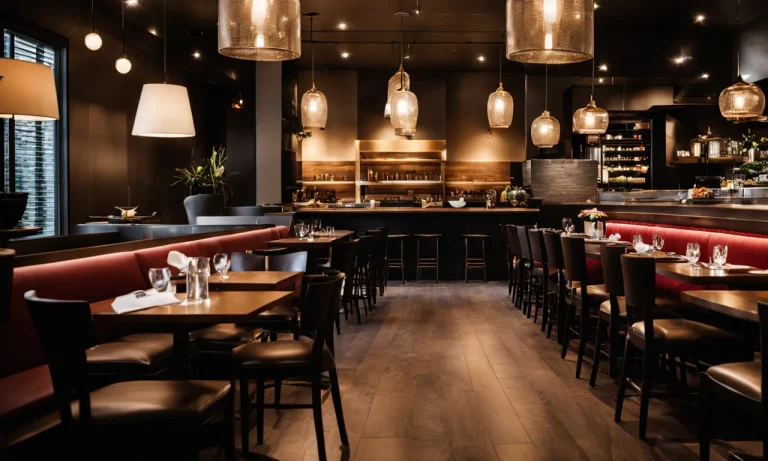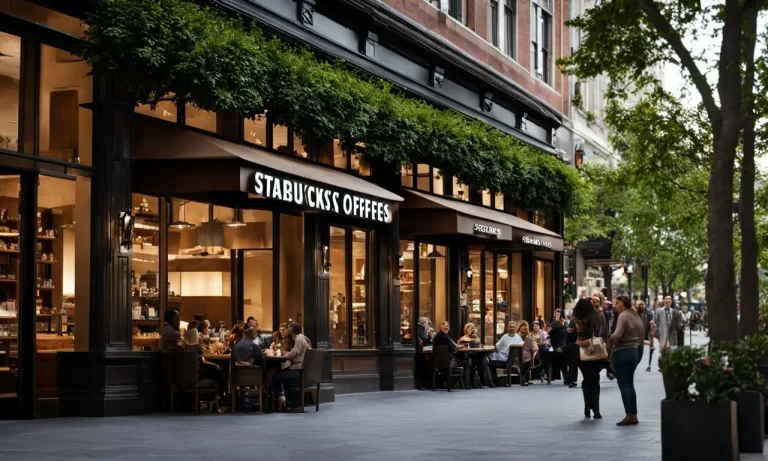Earning a Michelin star is one of the highest honors a restaurant can achieve. But what exactly does having a Michelin star signify, and how does a restaurant get one in the first place? If you’re short on time, here’s a quick answer to your question: Michelin stars are a rating system used by the French tire company Michelin to grade a restaurant’s food quality.
Restaurants can earn between one and three stars based on anonymous inspections by Michelin’s food critics.
In this comprehensive guide, we’ll cover everything you need to know about Michelin star restaurants. You’ll learn about the history of the Michelin guide, what criteria inspectors use to award stars, how rare it is for restaurants to earn three stars, and what happens when a restaurant loses its Michelin stars.
We’ll also highlight what you can expect from dining at a Michelin starred restaurant in terms of food, service, and ambiance.
History and Background of Michelin Stars
Created in the early 1900s, the Michelin Guide has become the go-to resource for food enthusiasts seeking exceptional dining experiences. The guide was initially developed by the Michelin tire company to encourage road trips and promote the use of their tires.
Over the years, it has evolved into a prestigious rating system that recognizes culinary excellence.
Creation of Michelin Guide in Early 1900s
The Michelin Guide was first created in 1900 by the Michelin tire company as a way to provide travelers with useful information about restaurants and accommodations along their journey. The guide started off as a simple booklet that included maps, instructions for changing tires, as well as a list of hotels and restaurants.
It quickly gained popularity and became known for its accurate and reliable recommendations.
Original Purpose Was to Encourage Road Trips
The primary purpose of the Michelin Guide was to encourage people to embark on road trips and explore different regions. The Michelin brothers, André and Édouard, believed that by providing travelers with information about quality establishments, they would be more likely to venture out and discover new places.
This concept of promoting travel and exploration through gastronomy was revolutionary at the time and laid the foundation for the Michelin Star system.
First Star Ratings Were Added in 1926
In 1926, the Michelin Guide introduced its first star ratings as a way to recognize exceptional culinary establishments. Initially, only a single star was awarded to restaurants that served “very good cuisine in its category.”
This rating system allowed the guide to distinguish between different levels of quality, helping readers make informed decisions about where to dine.
Highest Honor is Three Michelin Stars
The highest honor a restaurant can receive in the Michelin Guide is three stars. This prestigious accolade is reserved for restaurants that demonstrate exceptional culinary skills, creativity, and consistency.
Only a handful of restaurants around the world have achieved this level of recognition, making it a symbol of excellence in the culinary world.
To learn more about the history and significance of Michelin stars, you can visit the official Michelin Guide website here.
What Do Michelin Stars Signify?
Michelin stars are prestigious accolades awarded to restaurants by the Michelin Guide, a highly respected restaurant guidebook. These stars are a mark of excellence and are recognized worldwide as a symbol of exceptional cuisine.
The Michelin Guide was first published in 1900 by the Michelin tire company, with the intention of encouraging more people to drive and therefore increase tire sales. Over time, the guide evolved into a trusted authority on fine dining, with its star rating system becoming the ultimate achievement for chefs and restaurants.
One Star: High Quality Cooking
A restaurant that receives one Michelin star is deemed to have “high quality cooking” by the Michelin inspectors. This means that the establishment serves consistently delicious food, using quality ingredients and demonstrating skillful preparation and presentation.
While a one-star rating may not seem as impressive as higher ratings, it is important to remember that only a small percentage of restaurants achieve this recognition. It is a testament to the chef’s talent and the overall dining experience.
Two Stars: Excellent Cuisine Worth a Detour
A restaurant that is awarded two Michelin stars is considered to offer “excellent cuisine worth a detour.” This means that the food is not only of exceptional quality, but it also showcases unique flavors, innovative techniques, and a distinct culinary identity.
A two-star rating indicates that the restaurant is worth traveling to, even if it is not in the immediate vicinity. The dining experience at a two-star Michelin restaurant is likely to be memorable, with a focus on creativity and a commitment to culinary excellence.
Three Stars: Exceptional Cuisine Worth a Special Journey
The highest accolade a restaurant can receive is three Michelin stars, signifying “exceptional cuisine worth a special journey.” These restaurants are considered to be the crème de la crème of the culinary world.
They offer an extraordinary dining experience that is worth traveling long distances for. A three-star rating indicates exceptional food, impeccable service, and a unique ambiance. These restaurants often feature highly skilled chefs who push the boundaries of gastronomy, creating dishes that are both technically impressive and incredibly delicious.
Receiving a Michelin star is a significant achievement for any restaurant. It not only recognizes the talent and skill of the chef and kitchen staff but also highlights the overall dining experience. The Michelin Guide’s star rating system has become a benchmark for culinary excellence, guiding food enthusiasts to exceptional dining destinations around the world.
How Michelin Stars Are Awarded
Michelin stars are prestigious accolades given to restaurants that have achieved culinary excellence. These stars are highly sought after by chefs and restaurant owners around the world. But how exactly are Michelin stars awarded? Let’s take a closer look.
Anonymous Inspections by Michelin Critics
One of the key aspects of Michelin star ratings is the anonymous inspections carried out by Michelin critics. These critics visit restaurants without revealing their true identities, allowing them to experience the restaurant just like any other customer.
This ensures that the rating is based solely on the quality of the food and overall dining experience.
During these inspections, the critics pay close attention to various factors such as the freshness and quality of ingredients, the skill and mastery of cooking techniques, the creativity and presentation of dishes, and the consistency of the dining experience.
These anonymous inspections help maintain the integrity and impartiality of the Michelin star system.
Focus on Quality of Ingredients, Mastery of Cooking
When awarding Michelin stars, the emphasis is on the quality of ingredients and the mastery of cooking techniques. Michelin-starred restaurants are known for their use of top-notch ingredients, often sourced locally and seasonally.
Chefs at these establishments showcase their culinary skills by transforming these ingredients into exquisite and flavorful dishes.
The Michelin guide also takes into account the creativity and innovation displayed by the chefs. They look for unique and original dishes that demonstrate a deep understanding of flavors and textures. The ability to balance different elements and create harmonious combinations is highly valued by the Michelin inspectors.
Stars Can Be Awarded or Taken Away Annually
Maintaining a Michelin star is not a one-time achievement. These stars are awarded annually, and restaurants must consistently maintain their high standards to retain their stars. This means that even the most renowned Michelin-starred establishments are subject to scrutiny each year.
On the other hand, restaurants can also lose their Michelin stars if they fail to meet the expectations set by the guide. This keeps the pressure on chefs and restaurant owners to continually strive for excellence and ensure that their establishments are delivering exceptional dining experiences.
Less Than 1% of Restaurants Earn Three Stars
Earning a Michelin star is no easy feat, and earning three stars is even more rare. Less than 1% of restaurants in the Michelin guide achieve the coveted three-star rating. These three-star restaurants are considered to be among the best in the world, offering exceptional cuisine, impeccable service, and an unforgettable dining experience.
The rigorous criteria set by the Michelin guide make it incredibly challenging to achieve and maintain a three-star rating. It requires a perfect combination of exceptional cooking, creativity, consistency, and attention to detail.
The Dining Experience at a Michelin Star Restaurant
Expect Refined, Innovative Dishes
When dining at a Michelin star restaurant, one can expect a culinary experience like no other. These esteemed establishments are known for their commitment to excellence and innovation in the kitchen. Chefs at Michelin star restaurants are constantly pushing the boundaries of flavor and presentation, creating dishes that are not only delicious but also visually stunning.
From molecular gastronomy techniques to unique flavor combinations, each dish is a work of art.
According to a study conducted by Michelin, Michelin star restaurants are more likely to use locally sourced, seasonal ingredients compared to non-starred establishments. This dedication to quality and freshness is evident in every bite.
White Glove Service and Luxury Atmosphere
In addition to the exceptional food, the service at a Michelin star restaurant is also top-notch. Guests can expect to be treated like royalty from the moment they step through the door. The staff is highly trained, attentive, and knowledgeable about the menu and wine pairings.
The atmosphere at these establishments is often luxurious and elegant. From the meticulously set tables to the tasteful decor, every detail is carefully curated to enhance the overall dining experience. The goal is to create a memorable and immersive experience for the guests.
Tasting Menus vs A La Carte Dining
Many Michelin star restaurants offer tasting menus as the main dining option. These menus typically consist of a series of smaller courses that showcase the chef’s creativity and skill. Tasting menus allow guests to sample a variety of dishes and experience a range of flavors and textures.
However, some Michelin star restaurants also offer a la carte dining options, where guests can choose individual dishes from a menu. This provides more flexibility for those who prefer to customize their dining experience.
Prices Range from Moderate to Extremely Expensive
It’s important to note that dining at a Michelin star restaurant can be a pricey affair. Prices can vary depending on the number of stars awarded to the establishment, the location, and the overall experience offered.
While some Michelin star restaurants may offer more affordable options, others can be quite expensive.
| Number of Stars | Price Range |
|---|---|
| One Star | $$-$$$ |
| Two Stars | $$$-$$$$ |
| Three Stars | $$$$+ |
It’s worth noting that the price is not just for the food, but also for the overall dining experience, including the service, atmosphere, and attention to detail.
So, if you’re looking for an extraordinary dining experience that combines exceptional cuisine, impeccable service, and a luxurious ambiance, a Michelin star restaurant is definitely worth considering. Just be prepared to indulge in a unique and unforgettable culinary adventure!
What Happens When a Restaurant Loses Michelin Stars?
Michelin stars are the highest accolades a restaurant can receive, and losing them can have significant consequences for a restaurant’s reputation, finances, and even its future. Here’s a closer look at what happens when a restaurant loses its Michelin stars.
Loss of Stars Can Devastate a Restaurant’s Reputation
For many chefs and restaurant owners, a Michelin star is a symbol of excellence and validation of their hard work. Losing a star can be a blow to their reputation and can have a lasting impact on their business.
The dining community and food enthusiasts often place a great deal of trust in the Michelin Guide, and a downgrade can lead to a loss of trust and credibility.
Restaurants that lose their stars may also face negative reviews and criticism from both customers and industry professionals. This can further damage their reputation and make it challenging to attract new customers.
Financial Impacts from Reduced Customer Interest
Restaurants that lose Michelin stars often experience a decline in customer interest and footfall. Many food enthusiasts and tourists specifically seek out Michelin-starred establishments for dining experiences.
Losing a star can result in a decrease in reservations and overall sales, impacting the restaurant’s revenue and profitability.
In some cases, the loss of stars can lead to financial difficulties, especially for smaller or independent restaurants. The cost of maintaining high-quality ingredients, hiring skilled staff, and meeting the expectations of discerning customers can be challenging without the recognition and prestige associated with Michelin stars.
Incentive for Chefs to Innovate and Re-earn Stars
While losing Michelin stars can be devastating, it can also serve as a catalyst for chefs and restaurant owners to push themselves to innovate and regain their stars. The Michelin Guide provides valuable feedback and critiques, allowing chefs to identify areas for improvement and refine their culinary offerings.
Many renowned chefs have used the loss of stars as motivation to reinvent their menus, experiment with new techniques, and elevate their dining experience to win back the coveted Michelin stars. This drive to re-earn stars can lead to a renewed focus on creativity, quality, and attention to detail.
It’s worth noting that not all restaurants strive to regain their Michelin stars after losing them. Some may choose to redefine their concept, focus on different dining experiences, or pursue other forms of recognition.
Ultimately, the loss of Michelin stars can be a turning point for a restaurant, prompting changes and transformations in its culinary journey.
Conclusion
Michelin stars represent the pinnacle of culinary excellence according to the notoriously selective Michelin guide. Earning even one star takes incredible talent and dedication from a restaurant. Michelin star restaurants offer a refined dining experience with exceptional service, ingredients, and culinary creativity.
While expensive, they create amazing memories for food lovers willing to splurge on a special occasion.
The next time you see a restaurant boasting of Michelin stars, you’ll understand the time, care, and skill that went into earning that elite status. At the highest 3-star level, these restaurants represent the absolute best dining experiences in the world.






